When you buy through our links, we may earn an affiliate commission.
For guitarists with smaller hands, finding an instrument that is comfortable to play can be frustrating. If the neck is too thick or the frets too wide, your guitar playing will suffer.
The best guitars for small hands are designed to make it easy to form chord shapes on the fingerboard. The neck shape, fingerboard radius, and body style must all suit your hand size.
Our top pick is the Fender Kurt Cobain Jaguar NOS, which boasts a highly playable “Modern C” neck that is ideal for guitarists with small hands.
Every guitarist should take the time to find an instrument that is compatible with their hand size. In this guide, we’ve identified a range of acoustic and electric guitars for small-handed musicians to suit a range of musical styles and budgets. Let’s check them out!
Quick Summary of the Best Guitars for Small Hands
- Fender Kurt Cobain Jaguar NOS (Best Overall)
- Taylor GS Mini-e Koa Acoustic-electric Guitar (Best Acoustic for Small Hands)
- Fender Player Mustang 90 (Most Versatile Option)
- Martin LX1E Little Martin Acoustic-electric Guitar (Best Budget Guitar)
- Gibson SG Standard '61 (Best Rock Guitar for Small Hands)
- Squier Mini Strat (Best for Young Guitarists)
Best Guitars for Small Hands
1. Best Overall – Fender Kurt Cobain Jaguar NOS
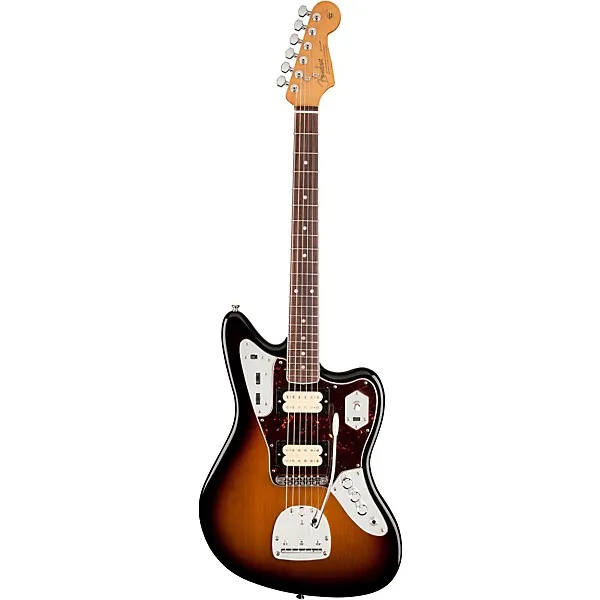
SPECS
- Body Type: Solibody
- Neck Profile: Modern C
- Pickups/Electronics: DiMarzio DP100 Super Distortion Humbucker (bridge) with DiMarzio PAF DP-103 Humbucker (neck)
- Fingerboard Material: Rosewood
This custom Jaguar, which is inspired by Nirvana legend Kurt Cobain’s modified guitar, is an excellent option for guitarists with small hands. Fender’s popular modern “C” neck profile has a gentle curve design, making it easier to form chord shapes and navigate the fretboard.
Although some guitarists find narrow frets easier to play, they can feel crowded, making it difficult to execute techniques like bending or applying vibrato. With 22 medium jumbo frets, the Jaguar NOS affords you plenty of room for expressive playing.
The fingerboard radius is 9.5”, which is ideal for guitarists who like to play fast, intricate styles. In addition to the physical design, this guitar’s tonal capabilities are exceptional.
Two slightly different DiMarzio humbucking pickups get you Cobain’s classic, high-octane tone that sounds as good on a heavy power-chord pattern as when you’re shredding in the higher registers. The lead and rhythm switch afford you even more freedom to sculpt your desired tones with this guitar.
This guitar is far from a one-trick pony - so don’t be fooled into thinking it can only be used for grunge or heavy rock. Its effortless playability makes it a great option for smaller-handed musicians who want to explore various tones and styles of playing.
2. Best Acoustic for Small Hands – Taylor GS Mini-e Koa Acoustic-electric Guitar
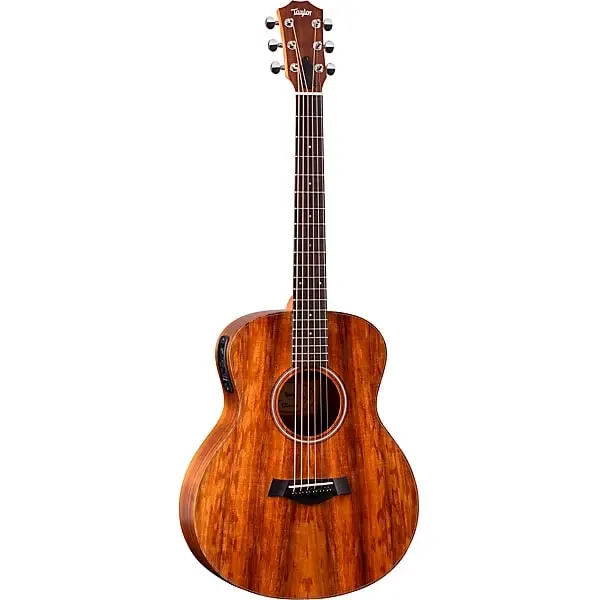
SPECS
- Body Type: Grad Symphony mini
- Neck Profile: Standard Carve
- Pickups/Electronics: ES-B preamp
- Fingerboard Material: Ebony
The Taylor GS Mini-e Koa is undoubtedly one of the best acoustic guitars for small hands. With its grand symphony body style, it offers a more comfortable alternative to full-sized guitars.
If you're concerned about losing volume and power by using a smaller guitar, the rich tone produced by the GS Mini-e Koa will alleviate your worries. Despite its compactness, I found myself very impressed by the fullness of this acoustic guitar's sound.
Through the combination of high-quality tonewoods such as Hawaiian koa for the body, ebony for the fingerboard, and sapele for the slim neck, Taylor has created an instrument that rivals any high-end parlor guitars for small hands and fingers.
Another thing that stands out about this small guitar is how well its natural tone translates from unplugged to amplified. If you play acoustic guitar in live performances, the consistency between the acoustic and electric sound will be very valuable.
Overall, this is an excellent alternative for those who find a full-sized guitar neck too strenuous on their hands and fingers. It improves playability without compromising on tone or power.
3. Most Versatile Option – Fender Player Mustang 90
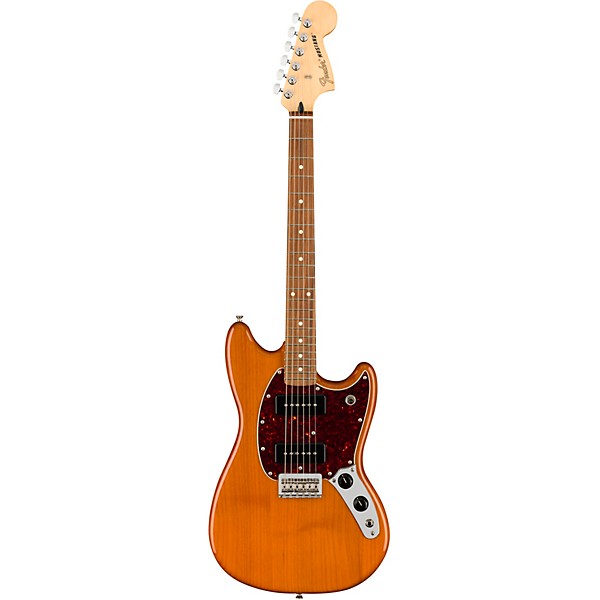
SPECS
- Body Type: Solidbody
- Neck Profile: C
- Pickups/Electronics: 2 x Mustand P-90 Single-coils
- Fingerboard Material: Pau Ferro
The Fender Player Series Mustang 90 boasts a unique combination of contemporary features with a classic design, making it one of the best electric guitars for small hands.
This versatile guitar is ideal for smaller frames, especially when you experience the comfort of the slim maple neck. The mixture of high-quality tonewoods and the reduction in size allows for easier chord transitions and fretting.
Along with its short scale length of 24", the Mustang 90 has a relatively small fingerboard radius, which further improves its suitability for those with small-handed guitar players. When you consider the playability and tone it produces, it's impossible to deny that this is a very affordable guitar.
Fender guitars are renowned for being excellent all-rounders, and this Mustang certainly lives up to that reputation. The P-90 single-coil pickups and the alder body make even the most simple barre chords sound energetic and interesting. Tuning stability is guaranteed by the hardtail bridge.
Although this is technically a short-scale guitar, it doesn't feel like you're losing out on any valuable space on the pau-ferro fingerboard. To top it off, the volume and tone controls are easy to access while you're playing, so you can make adjustments accordingly when required.
4. Best Budget Guitar – Martin LX1E Little Martin Acoustic-electric Guitar

SPECS
- Body Type: Modified 0-14 Fret
- Neck Profile: Modified Low Oval
- Pickups/Electronics: Fishman Sonitone
- Fingerboard Material: FSC Richlite
Little Martin guitars are fantastic options for those with small hands, particularly this beautifully designed LX1E. Not only does it offer uncompromising comfort, but it also promotes expression when you're playing it.
The thing that stood out to me initially about this Martin acoustic guitar was its scaled-down design. The 23-inch, modified, low oval-shaped neck is easy to hold and move around. It makes forming complex and intricate chord shapes a breeze.
If you like to transition from note to note with speed and accuracy, the 16" fingerboard radius will allow you to do this even if you have particularly small fingers. Furthermore, this is a great choice for those who are first learning to play guitar, as its design helps to reduce fatigue on your hands and arms.
Acoustic guitars for small hands can sometimes suffer from a lack of clarity compared to full-size guitars. However, this is not the case with the Little Martin LX1E.
It produces a strong midrange, with sweet highs and tight lows that sound great through an amp or P. A system when using the onboard Fisman Sonitone electronics.
5. Best Rock Guitar for Small Hands – Gibson SG Standard '61
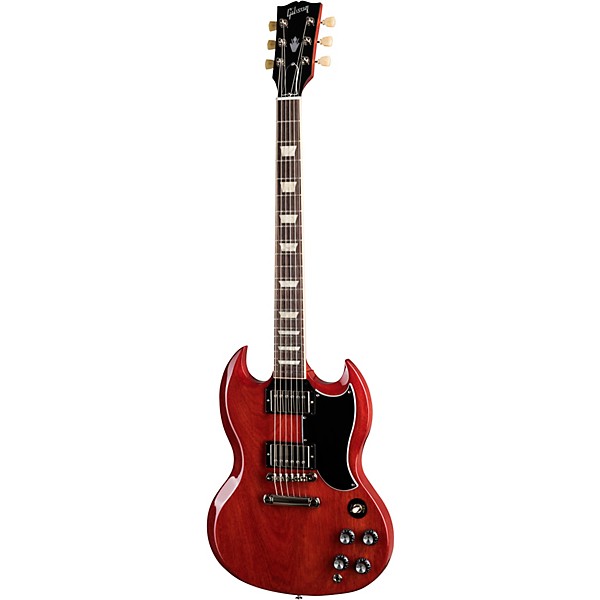
SPECS
- Body Type: Solidbody
- Neck Profile: Slim Taper
- Pickups/Electronics: 2 x Gibson 60s Burstbucker Humbuckers
- Fingerboard Material: Rosewood
The Gibson SG Standard '61 is a fine example of this iconic American manufacturer's commitment to the comfort and quality of its electric guitars.
When you have smaller-than-average hands, the last thing you need is a chunky neck that makes it difficult to stretch your thumb and fingers around. With its slim taper profile, this short-scale electric guitar makes getting your fingers in the correct positions on the fretboard much easier.
The SG Standard '61 also minimizes hand, finger, and wrist fatigue when playing guitar for long periods. The patented "Plek'd" frets are medium jumbo sized, striking a good balance between being accessible and spacious enough to play with freedom.
This is a great electric guitar for small hands due to its playability, and the SG Standard '61 also delivers a stellar sound. A pair of '60s Bursbuckers ensure a thick, warm output that suits all rock and metal styles, and the iconic double-horned mahogany body enhances its sustain and resonance.
6. Best for Young Guitarists – Squier Mini Strat
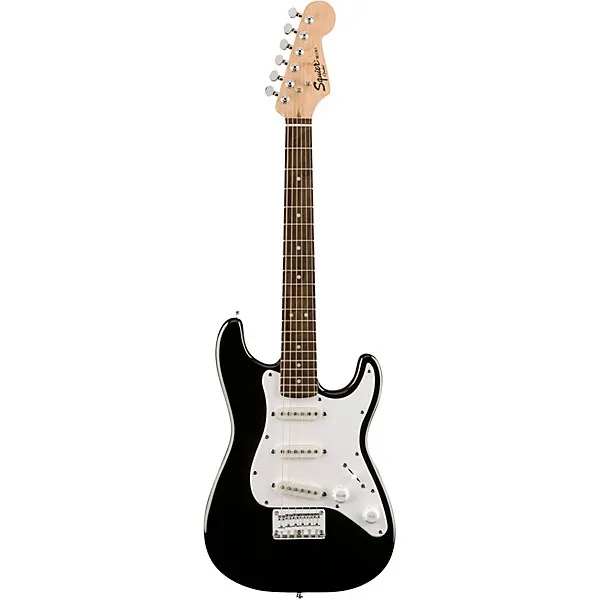
SPECS
- Body Type: Solidbody
- Neck Profile: C
- Pickups/Electronics: 3 x Standard Strat Single-coil
- Fingerboard Material: Indian Laurel
Mini guitars can be very hit-and-miss. Most don't come close to the playability and tone of a full-size guitar, but a select few manage to capture the essence of larger instruments - like the Squier Mini Strat.
An ideal option for a young guitar player looking to learn the basics, this compact version of Fender's iconic solid guitar boasts a comfortable neck with a "C" profile, so even short fingers can wrap around it to form chord shapes.
This guitar's scale length is perfect for those with short fingers or small hands. At 22.75", it's highly accessible and allows you to move around the fingerboard with confidence and accuracy.
Although it's one of the smaller electric guitars on our list, the Squier Mini Strat produces a surprisingly full-bodied tone when it's plugged into an amplifier. It's arguably the best electric guitar for youngsters or beginners.
Best Guitars for Small Hands Buyer’s Guide
Having small hands doesn’t have to be a disadvantage when you’re playing the guitar, but if you choose an instrument that isn’t suitable for you, it will be more difficult to play to your maximum ability.
Thankfully, as we’ve discovered already in this guide, there are several excellent guitars that are perfectly suited to this type of guitarist.
If you’re not too familiar with the technical specs of guitars, comparing them can be a somewhat confusing and frustrating experience.
In our buyer’s guide, we’ll take an in-depth look at the most important things you need to be aware of when deciding between the guitars we’ve recommended.
We’ll get into the various components and designs that make a guitar great for those with smaller hands and offer some advice on how to make the right choice.
Things to Look for When Buying Guitars for Small Hands
1. Neck Width and Profile
The width of the guitar’s neck, combined with its cross-sectional shape, greatly impacts its playability. People with small hands find narrower necks easier to play with in most cases, as it reduces the amount of stretching they have to do.
Neck profiles like the slim and modern “C” variety are solid choices as they are easy to grip.
2. Scale Length
The scale length of a guitar means the total distance between its bridge and the nut.
A guitar with a shorter scale length means there is less distance between each fret so that smaller-handed musicians can make chord shapes with their fretting hand more comfortably. However, shorter-scale guitars also impact the tone by increasing the warmth.
3. Body Size
The overall size of the guitar’s body directly affects its comfort and playability. Younger guitarists, or those who are smaller in general, may find large-bodied guitars difficult to control and hold in place.
Guitars with reduced-sized bodies might be a more suitable choice for smaller-handed players.
4. Fingerboard Radius
A guitar with a larger radius essentially has a flatter curve and is better suited to playing single-note melodies, riffs, or solos. Smaller radius guitars have more of a curve, which makes them a great choice for rhythm guitarists who often play chords.
Musicians with smaller hands may find playing a guitar with a smaller radius more comfortable.
Suitable Neck Profiles and Shapes
When it comes to identifying acoustic or electric guitars that are suitable for your hand size, understanding the differences between the various neck profiles is a must. Neck profiles directly impact the comfort and ease of play, particularly if you have smaller hands.
The most common type of neck profile suitable for musicians with smaller hands is the “C” profile - specifically, the modern “C” shape created by Fender and found on our top pick, the Kurt Cobain Jaguar NOS. This profile is easy to grip, comfortable, and suitable for a range of playing styles.
Profiles like the slim taper, which Gibson originally introduced in the late 1950s and features on the SG Standard '61 we recommended earlier, are ideal for small-handed guitarists.
This profile is also often known as the “D” shape, and it narrows towards the headstock of the guitar, allowing you to easily access higher frets.
Standard “C” neck profiles are a good choice if your hands are slightly smaller than average, as their curvature is gentle and easy to grip with your fretting hand.
How Fret Size Impacts Your Playing
Another integral aspect to consider when looking for a guitar for small hands is the size of the frets. Not only does fret size impact how much you need to stretch to reach different notes, but it also affects the finger strength that is required.
When we’re talking about fret size, this refers to both the height and the width of the fret wire. The height is also commonly known as the “crown,” so don’t be confused if you see this in the specs of a guitar.
Three common terms you’re likely to come across are “narrow,” “medium,” and “jumbo” frets. These are the categories that describe the combination of the height and width of the fret wires.
Narrow frets, also sometimes called “vintage” frets, are the smallest variety. They’re a great choice for younger guitarists or those with particularly smaller hands, as they don’t require much stretching to form chord shapes or reach different notes.
However, they sometimes make bending the strings and achieving vibrato harder.
Medium frets are a good option for most guitarists, as they represent a middle ground between the other more extreme sizes. They’re comfortable when soloing or playing chords and don’t feel crowded like narrow frets sometimes can.
Jumbo frets can be an okay choice, even for guitarists with small hands, but this depends on your preferences. They will require you to stretch more, but the additional space might be valuable and not too strenuous if the neck profile is slim.
Choosing the Right Body Size and Style
The size and style of the guitar’s body may not impact your hands in the same way as the fretboard and neck, but it still influences the instrument's sound and overall playability.
First, let’s look at some suitable acoustic guitar body styles for musicians with small hands. Larger-bodied guitars like the dreadnought and jumbo are arguably the least well-suited, but other options, like the concert, grand concert, parlor, and ¾ size guitars, are ideal.
Concert acoustic guitars are slightly smaller than Grand Concert guitars, but both of these varieties are great for producing a balanced tone with plenty of volume.
The parlor is significantly smaller, and ¾ sized guitars like the LX1E Little Martin are excellent guitars for small hands.
When it comes to choosing an electric guitar, solid-body instruments are generally better. Some semi-hollow or hollow body guitars may have slim necks and narrow frets, but they tend to be chunkier and, therefore, not the best choice for people with smaller hands.
Fingerboard Radius
The fingerboard of a guitar is not flat, contrary to popular opinion, but rather has a slightly curved design that plays its part in determining the playability - especially for musicians with smaller hands. The curve is commonly known as the fingerboard radius.
To gauge the fingerboard radius, a measurement is taken of the curve, which is calculated as if it were a segment of a full circle’s circumference.
Fingerboard radiuses range anywhere from 7.25”, which is a smaller, rounded radius, up to 16”, which is a much flatter and larger radius.
Depending on how small your hands are, you’ll probably want to opt for a radius that falls within the range of 7.25” to 9.5”. This will result in the curve matching the way your fingers naturally curve, improving playability and reducing strain.
Frequently Asked Questions (FAQs)
How does string gauge affect playability for those with small hands?
The string gauge, or the thickness of the strings, directly impacts the playability of acoustic guitars, classical guitars, and electric guitars. This is particularly true for individuals with small hands.
On the whole, the best guitar strings for small-handed players have a lighter gauge, as this requires less force to push them down in order to generate a sound. They cause less tension on the fingertips, resulting in less fatigue during long sessions playing guitar.
However, many guitarists prefer to use regular gauge strings as they produce a richer tone with more sustain.
Heavy gauge strings are probably not the best option for a guitar player with small fingers, but if the guitar has a particularly thin neck and is generally comfortable, they may suit specific styles of playing.
How does a smaller fingerboard radius affect chord formation?
Acoustic guitars or electric guitars for small hands should have a smaller fingerboard radius. The curved design makes it easier for short fingers to be wrapped around the neck, reducing the strain on the guitar player's hand.
There is, however, a drawback to this design. A smaller radius can make it easier to form chord shapes on the fingerboard, but it does often make playing lead parts more challenging.
The reduced space available to the guitar player makes it difficult to use techniques like bends. That's why many modern guitars for styles like rock and metal often have flatter fingerboard radiuses.
How does a guitar's body size influence comfort and control?
The body style and size of a guitar impact the amount of control you have while playing and the overall comfort dramatically. A smaller guitar body generally makes accessing all of the frets easier, while larger bodies offer improved sound projection.
For guitar players who are shorter, a smaller body will reduce the strain on their arms, shoulders, and wrists. There will be a compromise in volume, but it's often a worthy tradeoff for improved playability.
Closing Thoughts
Now that you’ve read our guide on the best guitar for small hands, you’ll hopefully have a clear idea of which models suit your specific needs.
Our top pick is the timeless Fender Kurt Cobain Jaguar NOS, with its highly playable modern “C” neck profile and overall comfortable design. If you’d prefer an acoustic guitar, the Taylor GS Mini-e Koa is an outstanding option thanks to its small body.
Whichever of you choose from our recommendations, I’m confident you’ll be blown away by the level of comfort you get when playing your new guitar, and the struggles of having small hands will be a thing of the past!
